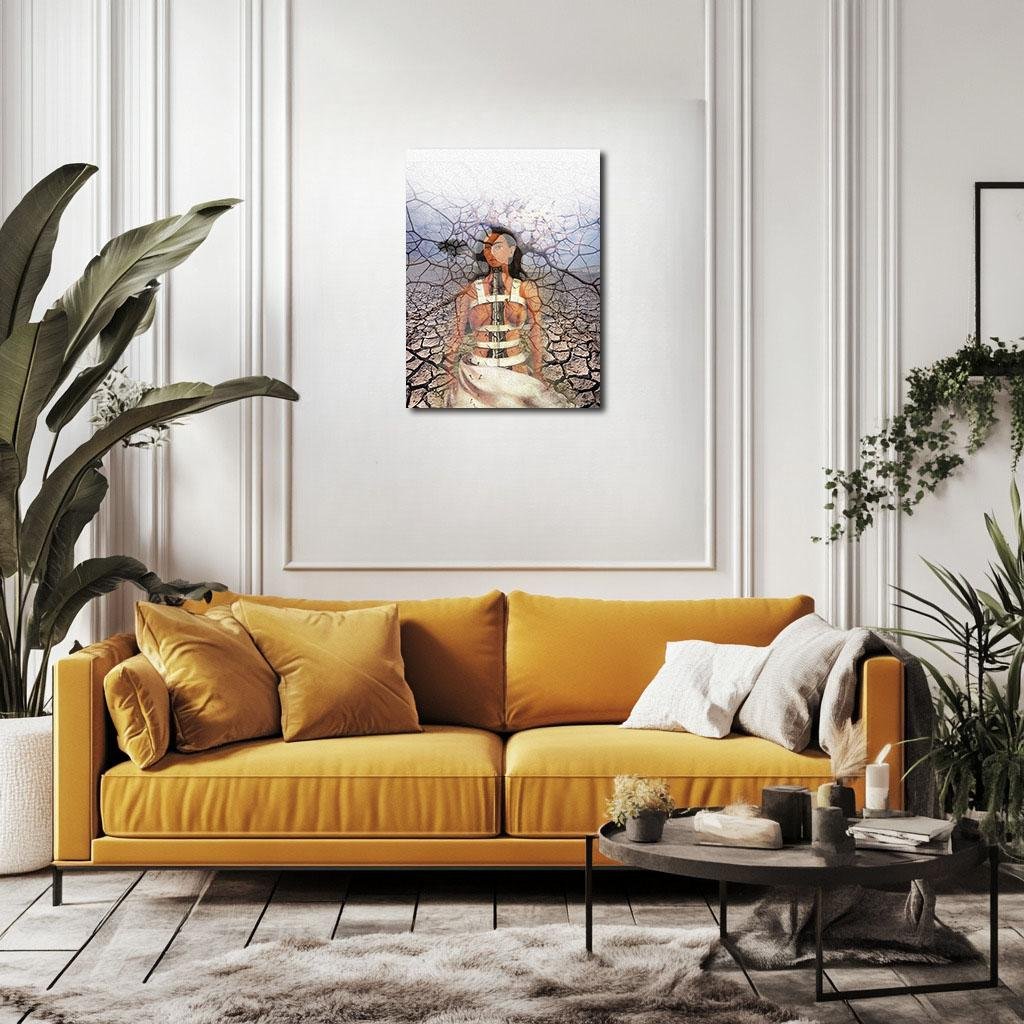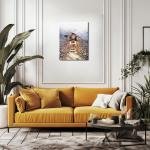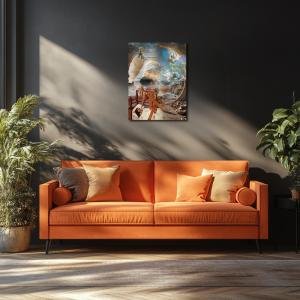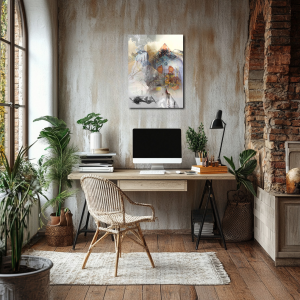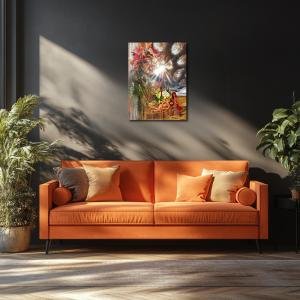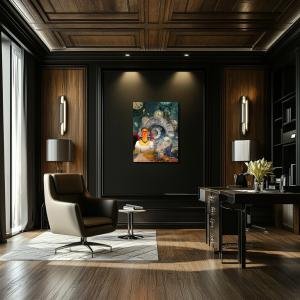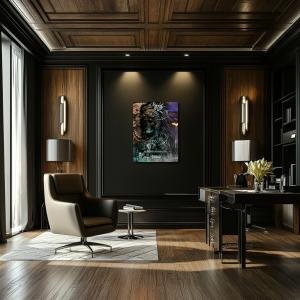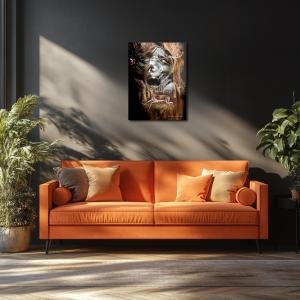Fractured Spirit: The Agony and Resilience of Frida’s Broken Column
This conceptual reinterpretation of Frida Kahlo’s The Broken Column amplifies the emotional and symbolic depth of the original work. By merging Kahlo’s fractured body with the cracked, barren earth, the piece creates a unified vision of vulnerability and strength. The muted earth tones and stark whites evoke a profound sense of isolation and resilience, while the nails piercing her skin symbolize the unrelenting pain she endured. This artwork celebrates Kahlo’s legacy, offering a powerful reflection on her ability to transform personal suffering into a universal language of hope and endurance.
Please see Below for Details…
Hotline Order:
Mon - Fri: 07AM - 06PM
404-872-4663
Frida Kahlo’s The Broken Column is a poignant exploration of the artist’s physical and emotional suffering, painted in 1944 following one of her numerous surgeries. The original painting, housed in the Museo Dolores Olmedo, portrays Kahlo as a modern-day martyr, her body split open to reveal a shattered ionic column in place of her spine. This column, fragile and fractured, serves as a stark metaphor for her broken physical state. In this conceptual reimagining, the arid and cracked earth extends Kahlo’s torment into the environment, creating a symphony of despair and resilience that amplifies the raw emotional depth of the original.
In the original work, Kahlo stands against a desolate background, her semi-nude form bound by a medical corset that barely supports her fractured body. Tears streak down her face, but her gaze is direct and confrontational, as though daring the viewer to look away from her pain. The cracked, barren earth in the background evokes a sense of sterility and hopelessness, reflecting Kahlo’s inner desolation. Nails pierce her skin, scattered across her face and torso, symbolizing her unrelenting physical pain and suffering.
This reinterpretation expands on the original imagery, emphasizing the interplay between Kahlo’s fractured body and the parched earth. The cracked landscape seamlessly merges with Kahlo’s wounds, creating a unified vision of vulnerability and strength. The texture of the dry, arid ground mirrors the fractures in the iconic column, drawing attention to the interconnectedness of physical pain and emotional turmoil. The barren environment reinforces the isolation Kahlo felt, both in her personal life and as a woman artist navigating a patriarchal world.
The colors in this work are carefully chosen to evoke a profound emotional response. The muted earth tones of the cracked landscape contrast sharply with the alabaster hue of Kahlo’s skin, emphasizing her vulnerability. The stark white of her medical corset and the column symbolizes purity and resilience, standing in stark relief against the darker tones. The subtle blues and grays of the background evoke a sense of melancholy, while the faint touches of red hint at the pain and sacrifice underlying her stoic expression. These colors, combined with the textural elements, create a multi-layered narrative that resonates deeply with the viewer.
Frida Kahlo painted The Broken Column after undergoing spinal surgery, which required her to wear a steel corset to support her fragile body. This painting, like much of her work, reflects her ability to transform personal suffering into a universal language of resilience and strength. The nails piercing her body symbolize the relentless pain she endured, while the open landscape reflects her feelings of isolation and longing. The tears streaming down her face add a layer of vulnerability, showing that even as she faced unimaginable hardship, she remained unapologetically human.
As an artist revisiting this masterpiece, my intention was to delve deeper into Kahlo’s emotional world, using modern techniques to reimagine her pain and resilience. The barren landscape serves as an extension of Kahlo’s body, emphasizing the interconnectedness of her inner and outer worlds. The interplay of textures and colors creates a dynamic visual experience, inviting the viewer to explore the layers of meaning embedded in the piece. By blending Kahlo’s iconic imagery with contemporary elements, this reinterpretation pays homage to her enduring legacy while offering a fresh perspective on her struggles and triumphs.
Kahlo’s life was marked by pain and resilience, both of which are vividly captured in this painting. Born in 1907 in Coyoacán, Mexico, she suffered a near-fatal bus accident at the age of 18 that left her with lifelong physical and emotional scars. Despite her suffering, Kahlo’s art is a testament to her indomitable spirit and her ability to find beauty and meaning in the face of adversity. The Broken Column is a powerful reminder of her resilience, offering a glimpse into her world and the strength she drew upon to create her art.
The conceptual reinterpretation of this piece also seeks to emphasize Kahlo’s role as a feminist icon and a pioneer in using art as a means of self-expression. The cracked earth, which forms the backdrop of this reimagined work, serves as a metaphor for the societal pressures and constraints Kahlo faced as a woman in a male-dominated art world. Yet, just as she endures the nails and the fractured column, she stands defiantly against these challenges, her gaze unwavering.
This artwork is special because it encapsulates Kahlo’s unique ability to transform personal suffering into a universal narrative of resilience and strength. Through her art, she invites viewers to confront their own pain and vulnerability, offering a message of hope and endurance. The conceptual elements in this reinterpretation highlight the timelessness of Kahlo’s themes, demonstrating their relevance in today’s world.
Add your review
Your email address will not be published. Required fields are marked *
Please login to write review!
Looks like there are no reviews yet.

